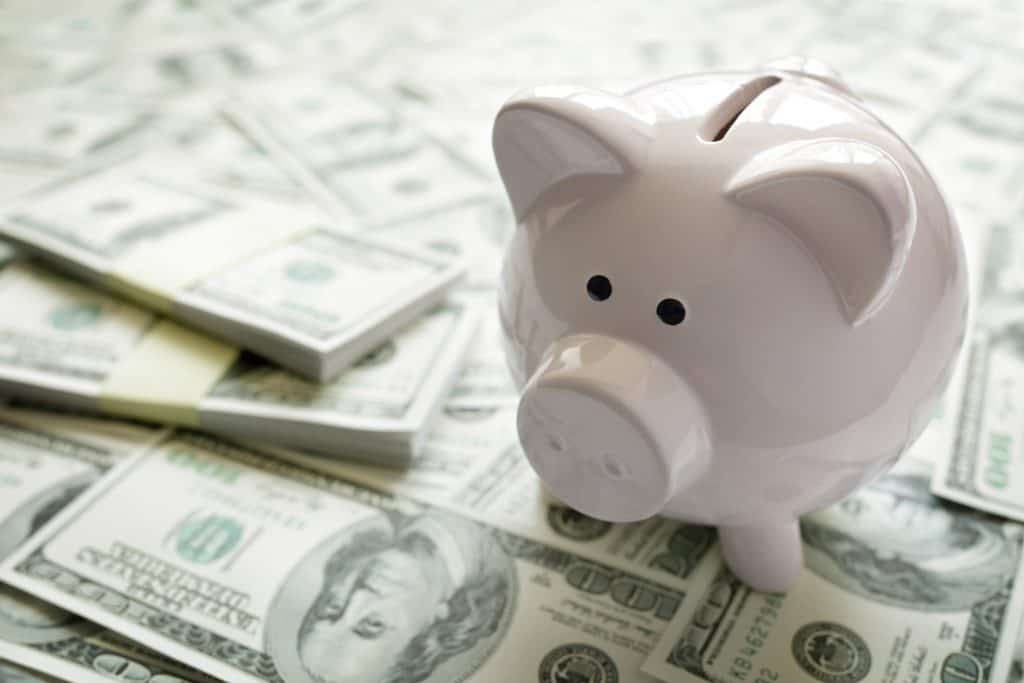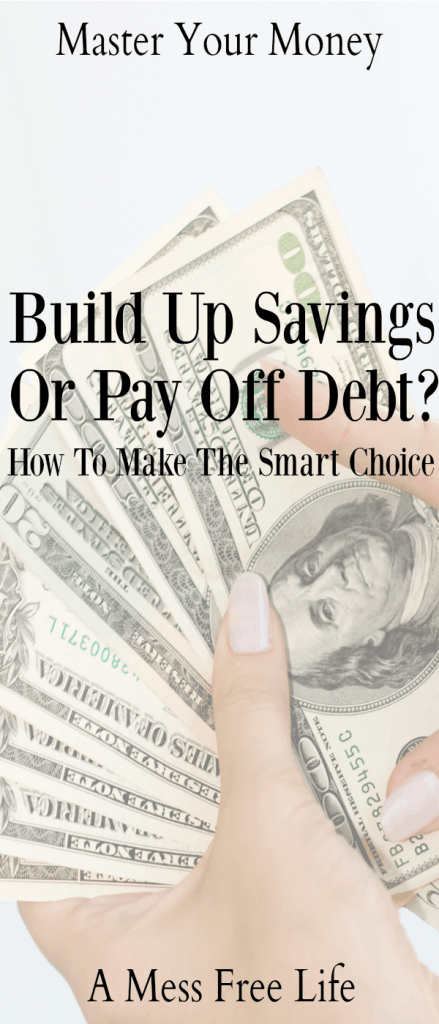A Mess Free Life may collect a share of sales or other compensation from the links on this page.
When faced with the decision to either build up savings or pay off debt, it can be a tough call to make. After all, you need to both. Each is as important as the other.
Building up your savings means you have a little security should something unexpected happen. An emergency fund for those things you hope don’t happen but always do. If you’re living paycheck to paycheck and just getting by without a lot of wiggle room in your budget, the idea of an unexpected expense can be scary.
If you’re living paycheck to paycheck and just getting by without a lot of wiggle room in your budget, the idea of an unexpected expense can be scary.
You never know when the car’s going to break down or the refrigerator is going to go on the fritz. It could even be something as simple as walking along and accidentally twisting your ankle, breaking a bone. That simple break could mean surgery and weeks off your feet, possibly weeks out of work.
How would you ever get through it without an emergency fund to fall back on?
And what about retirement? You’re probably going to want to do that at some point, and you’ll need money saved up to live off of. Building a retirement account is a top priority for that point in your life when you want to stop working and enjoy life a bit.
On the other hand, those loans and maxed out credit cards have high-interest rates and you’re paying much more than you actually owe by making just the minimum monthly payment.
If you could get rid of that debt, it would not only save you money every month, but it would also save you money over the long-term by avoiding additional interest payments.
The money you used to put towards debt could then go towards savings, and you’d be able to get that emergency fund built up. But what happens if the emergency comes before you’ve paid off the debt and you don’t have a fund to fall back on?
You’ll end up even deeper in the hole because you’ll not only have a loan and interest payments due but probably some late fees as well when you use your debt money for your emergency.
The decision can definitely be a difficult one. Both savings and debt are necessary, and they both need your attention (and your money!). So how do you make this happen when you’re already spreading yourself thin?
The answer is: One Step at a Time.
Table of Contents
SHOULD YOU BUILD UP SAVINGS OR PAY OFF DEBT?
When faced with debt and the realization you don’t have much tucked aside in a savings account for that inevitable rainy day we start to panic, and we want to rid ourselves of that feeling and fix the problem fast.
But nothing happens overnight unless you win the lottery.
It takes time.
I remember when I finally had that realization. I wanted to build up savings like yesterday, and of course, I wanted to pay off my credit cards as quickly as humanly possible.
But I knew the reality of my situation, and I knew it would take time. In the end, I paid off over 78K of debt in under three years.
Yes, it took incredible sacrifice and hard work – but I don’t regret any of the time and effort it took to get me to the point where I could finally exclaim I was debt free.
So, for now, stop worrying about how it will all come together in the end; for now just worry about the immediate baby steps you can take to start building up your savings and paying off debt.
STEP ONE – BUILD UP SAVINGS
First, create a small emergency fund. Not the full three to six months’ worth of income yet; we’ll get to that. Just a small fund of about $1,000 to help bridge the gap should an emergency arise is all you need to plan for right now.
This will give you a little security and help you out if the car needs a minor repair or some other small emergency comes up.
STEP TWO – PAY OFF DEBT
Pay off all debt except for your mortgage.
Use the snowball method to help you clear debt as quickly as possible. This just means paying off the smallest account first while making the minimum payment on larger balances. Once the smallest account is paid off, start on the next one and so on. Continue to make the minimum payments to the larger accounts to keep them current.
Once the first account is paid off, use the money you typically paid for that account and add it to what you are currently paying for the next account.
For instance, if you were paying $50 a month for the account you just paid off, add that to the amount you pay each month for the next account you’re paying off. This will help you to pay it off quicker.
Continuing doing this for each account you pay off until your loans and credit cards are paid in full. Only charge to the credit cards what you can pay off each month to keep the debt from building up again.
STEP THREE – MAKE IT BIGGER
Now that you have a small emergency fund and your debt is paid off, you can start feeling a little better about your financial future. You’re on the right path. It’s time for the next step which is building your emergency fund bigger and stronger.
The goal is to build your emergency fund to the equivalent of three to six months’ worth of expenses at a minimum. That amount will vary depending on your situation and other issues like self-employment and your age.
I have three years of living expenses saved. For me, at my age, this made sense for me and made me feel very secure if something were to happen and I was unable to work.
When my mother got sick a few years ago, my fund allowed me to now work for six months. Without that resource, I can’t imagine the stress I would have felt having to juggle my mother’s illness and working.
Think about where your regular income comes from. If you were to lose that, how long would it take to replace it? Is your job in high demand and you’d be able to find a job quickly? If so, three to four months should cover your needs. But if you are in a specialized field without many job openings, it may be harder for you to find a new position and you should plan on six months of savings or more.
Once you reach this point, you should be feeling pretty good about your financial situation. You have some money set aside if you should need it and you’re completely out of debt with the exception of your mortgage. You are leaps and bounds ahead of most people!
STEP FOUR – RETIREMENT
Now it’s time to think about your future and start planning for retirement. At this point, you can start looking for tax-free retirement accounts to start shifting some of your income to. A plan of about 15% of your income each month should help you build a nice retirement fund. And since you’re out of debt, you should be able to manage that pretty well.
CONCLUSION
So often people try to take care of all of their financial needs at once, but this only slows down your progress and leaves you unprepared for an emergency. Instead, work slowly but diligently on one financial goal at a time – build up savings before you pay off debt and give it all of your attention before moving on to the next goal.
This will help you reach your savings goals and get out of debt much faster.





